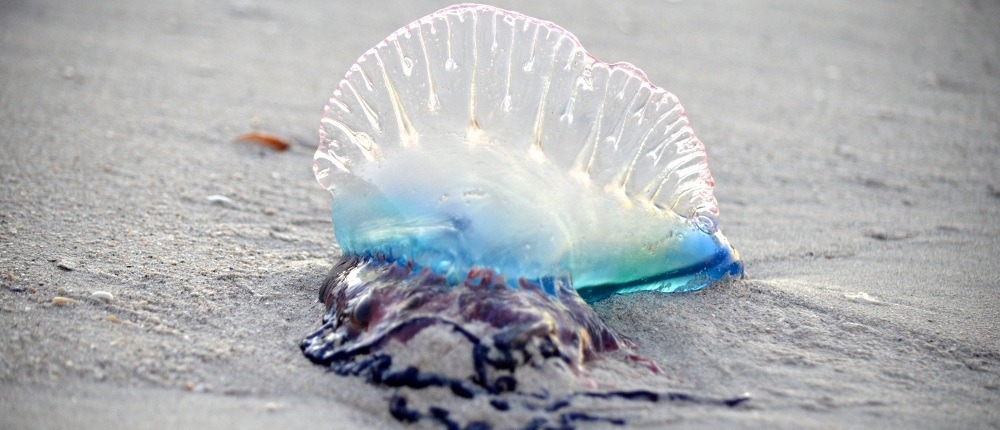Brainless sacks of water
I have always been more than a little spooked by Daleks. There is something truly terrifying about those evil aliens with their robotic shells. They attack without mercy and appear to have no soul. It is disconcerting to think that there might be creatures out there which you could never understand or reason with. My blood always runs cold when I hear “exterminate!”. I feel pretty much the same about jellyfish! They look distinctly unpleasant and not unlike alien invaders!
As there are so many dangerous animals on Earth, a sack of water without a brain may not seem to present a major threat. But jellyfish can pack a serious punch as I know only too well. I was stung by a diminutive purple jelly in the Mediterranean and it had a kick like a mule. I thought I had been assaulted with a cattle prod and the scars took three months to heal.
Born survivors
Jellyfish boast a physical structure which enables them to grow big and eat as much as possible without the negative effects of a high metabolism. They have survived every mass extinction on the planet and the squidgy critters have inhabited the oceans for over 600 million years. A jellyfish sting is one of the fastest known natural processes and last for as little as 700 nanoseconds. Jellyfish don’t sting you intentionally as the stinging mechanism is activated by simply brushing against them. I did not find any comfort in the lack of malice when that purple thing got me! The stings of some species are lethal while other jellyfish don’t sting at all. 3,000 different species have been identified and many are bioluminescent which means they can make their own light.
From beyond the grave
In addition to sharing many qualities with Dr Who’s greatest enemies, Jellyfish are the stuff of horror movies as they can sting you even when they are dead. Jellyfish should therefore not be touched when on the beach, even if they appear to be dead. The stinging cells remain active for a period of time and even walking along the water’s edge can be risky as there might be remains of tentacles in the surf. A period of 24 hours in the sun will deactivate the stinging cells.
Jellyfish are pelagic animals, which means they live in the open seas. They can propel themselves with rhythmic motions of their umbrellas, but they mostly move at the mercy of the currents.
Jellyfish invasions
I can recall spending several holidays at the seaside in the UK without ever seeing a single jellyfish. But now jellyfish invasions seem to be much more common. Every so often, I arrive at the beach to find it littered with my least favourite wildlife and the jellies can be huge. The arrivals of the enormous blobs are not chance events.
The primary reason that there are more jellyfish fetching up on beaches is the simple fact that there are more jellyfish in the oceans. Their populations are on the rise because climate change has enabled them to populate areas they would previously have avoided. In addition, whaling and over-fishing has reduced the number of predators which would otherwise keep jellyfish numbers down. So, these amazing survivors are thriving like never before. To make matters worse, the pollution which has been entering the oceans and reducing the populations of many species doesn’t appear to have hurt jellyfish at all. In fact, it has actually helped them by killing their predators. But none of this explains why beaches can be littered with jellyfish on some days and not on others.
The natural habitat of the jellyfish is the water 20 to 40 miles from the coast where the sea is more salty and a little warmer. Rivers and rainwater run into coastal waters, reducing salinity and so forming a barrier which keeps the jellyfish at bay. But in periods of low rainfall, the volume of fresh water entering the sea diminishes, causing coastal waters to become as salty as those offshore. That’s when the jelly invasions begin.
With a limited ability to swim against ocean currents, jellies become concentrated into dense blooms which are often close to the surface. The blooms will occasionally be stranded on beaches at the high tide mark. It all looks very spectacular but also rather creepy!
Jellyfish in North Wales
Several species of jellyfish can be found in our waters and sometimes in large numbers on our beaches. Here are the species which you might encounter and the low down on their capacity to sting.
WHICH JELLYFISH WILL YOU SEE IN NORTH WALES?
WHICH SPECIES STING?
Barrel Jellyfish
These utterly revolting blobs (Rhizostoma pulmo) are common in the Irish sea and can wash up on the beaches of North Wales in large numbers. Typically up to 40cm in diameter, they can grow as large as 90cm. This is the largest jellyfish that visits British waters and it looks very intimidating. However, these nasty looking creatures feed on plankton and so don’t need a potent sting. Apparently, their sting is too weak to hurt humans but I have never summoned up the courage to test the theory! You will see plenty of barrel jellyfish and they can appear throughout the year.
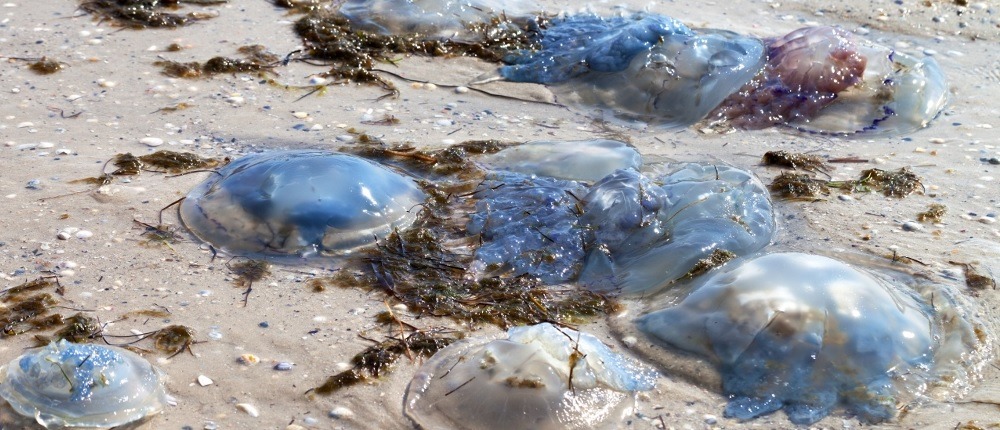
Moon Jellyfish
The moon jellyfish (Aurelia aurita) is the most common jellyfish in Wales. Usually 25-40cm in diameter, it is notable for its four horseshoe-shaped gonads and feeds on plankton and molluscs. You will see these translucent chaps throughout the year but there’s no need to worry about bumping into them when you are swimming because they have a very mild sting which cannot penetrate human skin. Phew! Moon jellies have short, delicate tentacles that hang down from the sides of the bell. They look very graceful in the water and I could almost like them – from a distance!
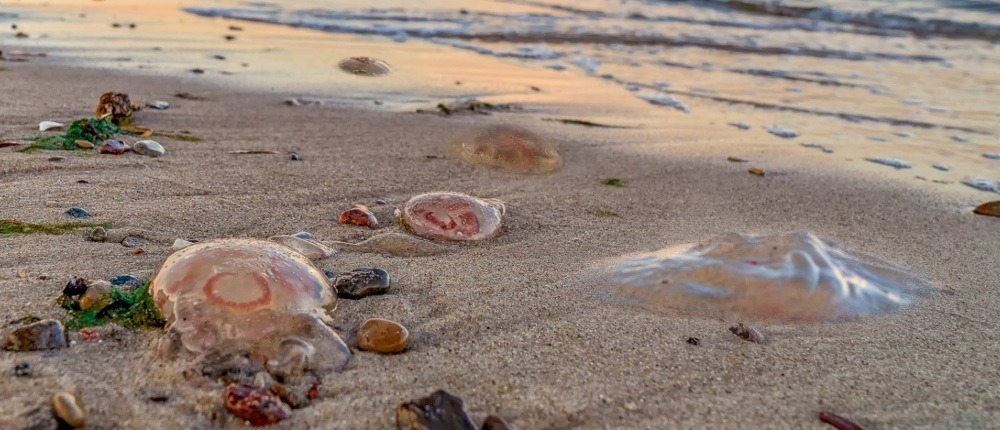
Blue Jellyfish
Easily recognisable by its colour, the blue jellyfish (Cyanea lamarckii) grows up to 30cm in diameter but usually about half this size. These jellies can sting you but the sensation is said to be similar to that of stinging nettles although some people say they have received a painful sting from them. I could live with a sting similar to nettles! I have never actually seen blue jellyfish in North Wales but I am sure I will eventually – hopefully not when I am right next to one in the water just in case that nettles thing is an understatement.
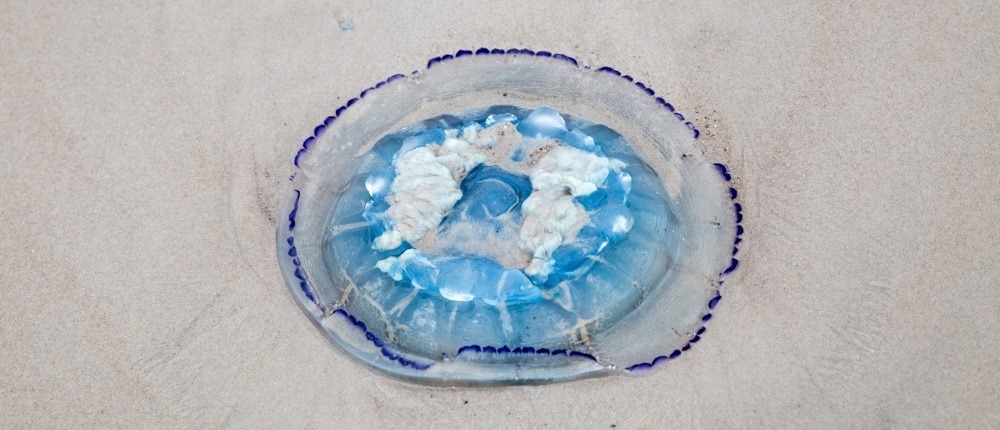
Lion’s Mane Jellyfish
You really don’t want to bump into one of these! Lion’s Mane jellies (Cyanea capillata) can grow up to 2 metres in diameter but thankfully those which visit North wales tend to be a lot smaller – up to 50cm. Size matters but with these critters the sting matters more. They can give you a serious sting which may need medical attention. There seem to be more and more Lion’s Mane jellies washing up on our beaches and you can’t miss them as they are rust brown in colour. They have up to 150 tentacles which can break off and they still sting!
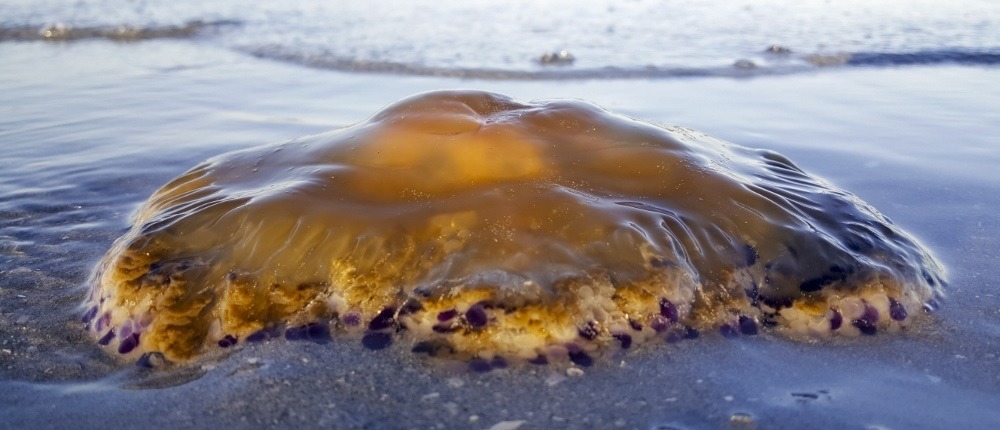
Compass Jellyfish
The Compass jellyfish (Chrysaora hysoscella) is a stinging species and the stings can be quite painful. This jelly is easily identified by the its brown y-shaped markings which are like the divisions on a compass. Frequently washing up on beaches in the summer months, the Compass Jellyfish feeds on small fish, crustaceans and even other jellyfish. It inhabits relatively shallow water and specimens can be up to 30cm in diameter. These aren’t the largest or most sinister looking jellies but should be given a wide birth!
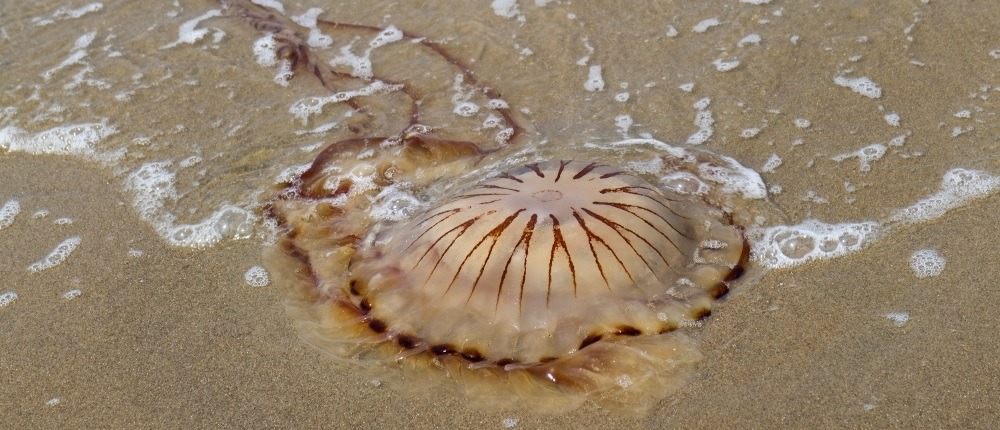
Portuguese Man O’ War
They sound rather unpleasant and they are! The Portuguese Man O’ War (Physalia physalis) is renowned for its venomous and potent sting. It isn’t actually a jellyfish but rather a close relative of jellies which composed of a colony of hydrzoans living together and behaving as if one animal. These nasty creatures are rare in UK waters but they do visit our shores, although usually in the south. Their sting is described as agonising and it is potentially lethal. If you are unfortunate enough to get caught, seek medical attention immediately.
